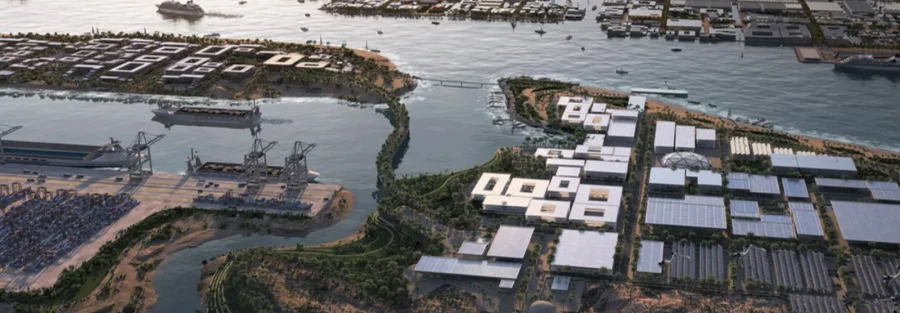When Saudi Arabia first revealed NEOM to the world, it sounded like a promise, a vision of living and industry reimagined for the century ahead. Within that vast project, one name has started to emerge not just as a part of NEOM but as its industrial heart: Oxagon. On the surface, it’s an industrial port city. At its core, it’s becoming a global experiment in turning renewable energy into trade, built around one powerful idea, green hydrogen.
The Hydrogen Core
The foundation of Oxagon’s story lies with the NEOM Green Hydrogen Company (NGHC), a joint venture between ACWA Power, Air Products, and NEOM. In 2023, it achieved financial close on an $8.4 billion project designed to produce around 600 tonnes of hydrogen per day, converted into green ammonia for export. The project is backed by $6.1 billion in non-recourse debt from 23 global and regional banks, an early sign that investors believe Saudi Arabia’s energy transition is more than words.
The energy feeding this production won’t come from oil or gas. Instead, about 4 gigawatts of solar and wind power will drive the electrolysers that split water into hydrogen and oxygen. The output will be combined with nitrogen to create ammonia, a molecule easier and safer to ship. The math is straightforward: one tonne of hydrogen translates into about 5.6 tonnes of ammonia, meaning Oxagon could produce more than 1.2 million tonnes of green ammonia annually. For Saudi Arabia, this isn’t just a clean-energy project; it’s a strategic move to place itself at the center of the emerging global hydrogen economy.
Progress and Scale
Oxagon’s defining feature is its alignment with NEOM’s plan to create the world’s largest hydrogen-based economy. The scale of this project, combining energy, logistics, and technology, makes it one of the boldest industrial transitions underway globally.
As of early Q1 2025, NEOM Green Hydrogen Company confirmed the project is over 80% complete. This includes the hydrogen production plant, wind garden, solar farm, and transmission grid. The 4 GW solar and wind generation component is expected to be completed by mid-2026, followed by commissioning of the electrolysers, with the first exportable ammonia anticipated in 2027.
Why Oxagon Matters
Oxagon’s location is as deliberate as its design. Built along the Red Sea near the Suez Canal, it sits on one of the world’s busiest trade corridors linking Asia and Europe. The Port of NEOM, officially opened for business in May 2023, is already operational under its first development phase. It occupies roughly 48 square kilometers, with plans for a capacity of 1.5 million TEUs once fully developed. That scale matters because hydrogen, and particularly ammonia, is not only about production but about movement, about where and how these molecules can be stored, loaded, and shipped to markets that need them.
The port is more than a logistics facility. It represents a transformation in how industrial hubs are built. Instead of treating energy, manufacturing, and shipping as separate systems, Oxagon integrates them into one ecosystem. Hydrogen production plants sit close to ammonia storage, which sits close to deepwater berths capable of handling future ammonia carriers. Every kilometer saved between production and export translates to cost efficiency, lower emissions, and global competitiveness.
Turning Hydrogen into Trade
For now, the key buyer is already defined. Air Products, one of the world’s largest hydrogen companies, holds a 30-year offtake agreement to purchase the entire output of NEOM’s green hydrogen facility. It will ship that hydrogen in ammonia form to international markets, where it can be cracked back into hydrogen or used directly as fuel or fertilizer feedstock.
The logistics are not small-scale. To move around 1.2 million tonnes of ammonia per year, Oxagon will require export infrastructure capable of loading medium to very large gas carriers, each typically holding 30,000 to 90,000 cubic meters of cargo. This means specialized refrigerated storage tanks and marine loading arms to handle cryogenic conditions safely. Each element must meet global safety and environmental standards, a quiet reminder that building the future means mastering the details.
That infrastructure is already forming. Hassan Allam Construction, an Egyptian contractor, is developing Container Terminal 1. It is now expected to open in 2026, not 2025 as earlier planned. Terminal 1 will feature automation, including remote-controlled cranes, and infrastructure like a deepened access channel and quay wall is already under construction. This terminal will anchor Oxagon’s global trade capacity, linking its industrial output to markets from Asia to Europe.
The Emerging Industrial Cluster
Oxagon isn’t just about energy; it’s about synergy. The city’s planners envision an industrial ecosystem that blends manufacturing, energy, logistics, and even data infrastructure. A striking example is the DataVolt project, a planned $5 billion investment for a 1.5 gigawatt net-zero AI data campus, expected to begin operations around 2028. The connection between data and hydrogen may seem distant, but both rely on reliable, sustainable power and advanced infrastructure.
As industries such as green steel, fertilizers, and synthetic fuels evolve, having hydrogen and ammonia within arm’s reach will make Oxagon an attractive site for global manufacturers seeking to decarbonize. It’s a place designed not only to export molecules but to attract industries that will use them.
Risks and Realism
For all its promise, Oxagon faces real tests. Large-scale hydrogen production at this magnitude has few precedents. Supply chain constraints in electrolyser manufacturing, technical risks in ammonia storage, and volatile shipping conditions in the Red Sea, especially amid ongoing security disruptions, are all significant hurdles. Recent reports also noted that the Public Investment Fund marked down some giga-project valuations, reminding observers that vision and execution are two different timelines.
Even so, the project’s 2025–2027 construction schedule is holding steady. As of mid-2025, NEOM reported that its green hydrogen facility was about 80 percent complete. For a project of this complexity, that progress is tangible. It shows that while global attention often focuses on renderings, cranes and welders are already shaping this ambition into steel and concrete.
Trade Corridors and Global Demand
Oxagon’s potential doesn’t stop at Saudi borders. The global demand for ammonia as an energy carrier is rising sharply, with Japan, South Korea, and parts of Europe investing in import terminals designed for green ammonia rather than traditional fossil fuels. Analysts expect global hydrogen trade to reach $500 billion by 2050, with green ammonia as its most transportable form.
Saudi Arabia’s bet, therefore, is not only environmental but geopolitical. As Europe and Asia shift away from fossil fuels, they will still need energy imports. The question is what form those imports take. If Saudi Arabia can export clean molecules rather than hydrocarbons, it could extend its energy leadership into the decarbonized era.
What Comes Next
In the next two years, the milestones are clear. Container Terminal 1 is scheduled to open in 2025, forming Oxagon’s logistical base. NGHC’s first ammonia shipments are expected between 2026 and 2027, marking Saudi Arabia’s entry into the global green hydrogen trade. By 2028, DataVolt’s AI campus aims to go live, symbolizing a new type of industrial clustering where clean power fuels both machines and computation.
Each of these dates is a checkpoint on a much longer journey, one that tests how fast industrial innovation can move from vision to vessel.
Built Around a Molecule
At its heart, Oxagon is not a city of glass towers or futuristic facades. It’s a machine built around a molecule, a place where sunlight and wind are turned into hydrogen, hydrogen into ammonia, and ammonia into trade. It connects Saudi Arabia’s renewable ambitions to the world’s demand for clean energy, creating a port that ships not barrels but molecules of air and water transformed.
The path ahead will not be smooth. Markets fluctuate, infrastructure takes time, and technologies evolve. But if Oxagon fulfills even part of its vision, it will mark the moment Saudi Arabia shifted from exporting oil to exporting the fuel of the next century.
The story began with hydrogen, and it will end there too, with a single idea that the future of trade may be built not on what we dig from the ground, but on what we can make from the wind and the sun.





